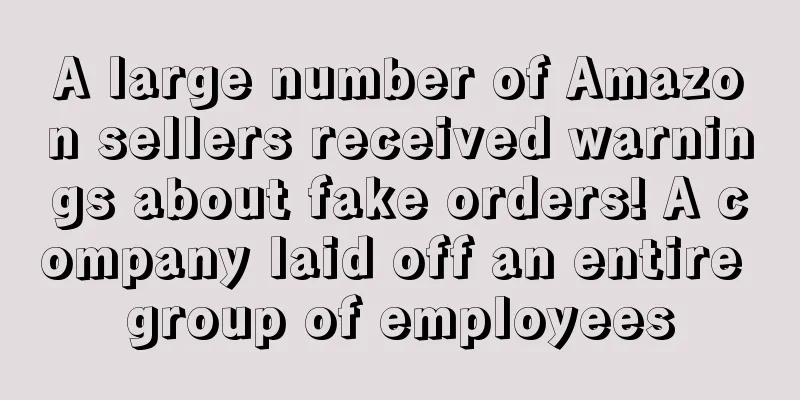A large number of Amazon sellers received warnings about fake orders! A company laid off an entire group of employees

|
Despite Amazon's crackdown, fake reviews still exist. Yesterday, a large number of Amazon sellers received fake review warnings, which once again reflects the platform's attitude towards illegal behavior. Affected by the account suspension incident, companies in the industry have begun to lay off employees one after another. One company laid off an entire group of people ...
As the crackdown continues, the rising shipping costs have also increased the burden on sellers. However, the White House has taken action to curb shipping prices, so sellers can expect a reduction in shipping costs.
A large number of Amazon sellers received warnings about fake orders
Yesterday, a large number of Amazon US sites received warnings about fake orders again.
The warning from Amazon is roughly as follows: We understand that you have provided compensation for buyer reviews. If we learn that sellers, suppliers, or others have attempted to manipulate reviews, Amazon will conduct an investigation. This includes providing compensation to buyers in exchange for reviews. If this problem persists, we will deactivate your account.
It is worth noting that some sellers on the US site received warning emails in Japanese, and some sellers do not even have accounts on the Japanese site. One seller said that it was impossible for the US site to receive Japanese emails, and he had never encountered such a situation.
In view of this situation, some sellers speculated that this might be a mass email from Amazon's robots. However, more sellers began to pay attention to this issue. Sellers who pay attention to this issue believe that Amazon generally does not send mass warning emails for no reason. The platform must have detected that the seller's account has fake orders, or has previously been found to have fake orders before issuing a warning.
It is understood that many of the sellers who received the warning did engage in fake orders. One seller who was caught said that he had only tested 1 to 2 orders a day recently , and he did not expect to receive a warning letter so soon.
Another seller who received a warning email said that he had not dared to place fake orders recently, but he had done reviews before and was caught this time. In addition, a seller who stopped doing reviews in October last year and has not placed any fake orders since then also received a fake order warning email recently.
According to analysis by industry insiders, most of the sellers who received warnings this time were evaluated by service providers. There are many buyer accounts of service providers on the market that have quality issues. Their review rates are too high, and they are easily judged as suspicious by Amazon.
As a seller, do not doubt Amazon's system. The world's top technology company will definitely find a way to detect your violations. In fact, as long as you have fake orders, you may be caught. After Amazon sends you an email warning, they will consider blocking your account.
Since the end of April, Amazon has banned nearly 300 seller accounts, including some big sellers in the industry. While many big sellers have had their accounts banned, some people are still placing fake orders and doing reviews. Last month, a service provider’s ads for reviews were everywhere, and more than 100 sellers left messages at the bottom of the ads seeking review channels.
Despite Amazon's severe crackdown, the reviews have not stopped. Perhaps the email sent by Amazon this time is a serious warning to sellers. Sellers must not harbor luck. If they do not stop brushing orders, when their accounts are blocked next time, some people will cry out that they are wronged. In fact, they have violated the rules before, so it is not wronged.
A company laid off an entire group of people, and 4 people left on the same day
After being caught for fake orders, the next step is to have your account shut down. In this Amazon account blocking operation, many big sellers were the first to be affected, and some companies have reported layoffs.
Yesterday, the editor saw a layoff diary shared by an employee of a big retail company.
The diary mentioned: "In mid-June, I was ready to work hard, but a week later, the company's largest Amazon brand was blocked, and sales flow was directly reduced by half. Then the company laid off a large number of employees, from more than 900 to more than 300. The entire team was fired, and four people submitted their resignation forms on the same day. The layoffs reflected the pain of the common people."
After problems arose with the company’s account, employees were laid off and suddenly lost their jobs. It all happened so suddenly that industry practitioners could not help but sigh: Will our journey at Amazon come to an abrupt end?
Regarding layoffs, a seller in the industry also said that he has recently heard from friends around him that a certain company has started to lay off employees , and it seems that it is very easy to recruit people recently . However, doing business on Amazon is not just about hiring a few people. Not violating regulations and operating in compliance is the first rule.
The ecosystem of cross-border sellers is not just about operations on the platform, but also about logistics and supply chain. This week, some sellers reported that shipping prices have risen again.
Ocean freight rates rise
In the past two days, sellers have given more feedback on the price increase of ocean freight:
“——Sea freight prices have risen so high ——The freight forwarder just said that the price has increased this week ——The price of US ocean freight has increased ridiculously”
A seller received the following freight forwarding quotation today:
Among them, the price of 100 kilograms on a regular ship from the East Coast of the US is 18 yuan, while that from the China and West Coast of the US is 17 and 16 yuan respectively.
Sellers complained that ocean shipping was too expensive, and freight forwarders also had their complaints, after all, the price of the cabinets was set. One freight forwarder was very helpless: "Customers are not shipping anymore, ocean shipping costs have risen too high, and we can no longer do business on the US route."
Regarding the continuous increase in ocean freight prices this year, some freight forwarders believe that the current prices have not yet reached their peak and will rise more sharply in late July and early August. Matsun has increased the California port congestion surcharge, which will take effect on August 5; Zim has also increased the port congestion surcharge and destination freight, which will take effect on August 1. At that time, ocean freight prices may see a wave of increases.
At present, the editor has consulted many freight forwarders about the recent shipping prices. Most of them said that there has been no price increase recently, and most of the quotations are at levels such as 14 or 15.5. However, some freight forwarders said that the price has indeed increased, "twice a week" and "20 oceans", but this price has been questioned by many freight forwarders.
Overall, shipping prices have seen huge increases this year.
The Drewry World Container Index, released last Thursday, showed that the spot price of a 40-foot container from Shanghai to Los Angeles rose to $9,631, up 5% from the previous week and 229% year-on-year. The composite index reflecting eight major trade routes rose to $8,796, up 333% year-on-year. Drewry said it expects freight rates to rise further in the coming week.
But some freight forwarders said that the current price is more than that. "It was over 10,000 US dollars last year, and now it is close to 20,000 US dollars." Foreign trade and cross-border sellers lamented that the exchange rate and freight costs over the past year were really unbearable. However, shipping companies have made a lot of money in the past two years, making up for the losses in previous years.
That's absolutely correct.
In the first quarter of this year, COSCO SHIPPING Holdings achieved operating income of 64.84 billion yuan, a year-on-year increase of 79.58%, net profit attributable to shareholders of the parent company of 15.45 billion yuan, a year-on-year increase of 5,200%, and net profit attributable to shareholders of the parent company excluding non-recurring items of 15.41 billion yuan, a year-on-year increase of 202.38%.
Last week, China COSCO Shipping Holdings released its semi-annual performance forecast, estimating that the net profit attributable to shareholders of the listed company in the first half of the year will be approximately RMB 37.093 billion, an increase of approximately 32 times from RMB 1.131 billion in the same period of 2020; the net profit attributable to shareholders of the listed company after deducting non-recurring gains and losses will be approximately RMB 37.021 billion, an increase of approximately 41 times year-on-year.
This number has shocked many people. Although the epidemic has made transportation more difficult, shipping companies have taken advantage of it. Since May last year , the share price of COSCO Shipping Holdings has soared.
But there may be a turnaround for the world's troubles caused by soaring shipping prices.
Last week, the White House said that U.S. President Biden will order the agency responsible for transportation regulation to crack down on anti-competitive behavior and unfair charges in the rail and shipping industries, trying to reduce consumer costs to address the problem of rising freight rates since the COVID-19 pandemic.
The order will urge the Federal Maritime Commission to work with the Department of Justice to investigate and punish anticompetitive behavior. The order will also encourage the Federal Maritime Commission to work to protect U.S. exporters from high costs imposed by ocean carriers and combat unfair fees.
The Federal Maritime Commission and the U.S. Department of Justice’s Antitrust Division on Monday signed the first-ever memorandum of understanding to strengthen economic oversight of foreign ocean carriers serving the United States’ international container trade.
Will the shipping situation change in the future? |
<<: Indian e-commerce to reach $120 billion by 2025
>>: European sellers, please note that there are new rules for Amazon listings!
Recommend
What is PayFast? PayFast Review, Features
PayFast offers flexible payment options for any b...
eBay reminds sellers to pay attention to carrier rate changes in 2022
Recently, eBay issued a new announcement to remin...
TikTok live streaming is gaining popularity, but I don’t know if it’s a real trend or…
Recently, a girl who live-streamed and sold goods...
Maternal and child products are popular in Southeast Asia, and eight products are hot-selling on Lazada!
Many Lazada sellers know that maternal and infant...
What is feiyue? feiyue Review, Features
Founded in Shanghai in 1920, Feiyue crossed border...
What is Zeepay? Zeepay Review, Features
<span data-docs-delta="[[20,{"gallery"...
What is Hengjieshi International Express? Hengjieshi International Express Review, Features
Hengjieshi International Express is an express bra...
What is teacakesyork? teacakesyork Review, Features
TeacakesYork has been supplying the highest qualit...
Net profit exceeds 1 billion? This track is popular
Recently, there have been various news about Tian...
What is Salesbacker
Salesbacker is an automated email sending tool fo...
Indian e-commerce market expected to reach $99 billion by 2024
The recently released EY - IVCA India 2021 Trends...
What is Shenmai E-commerce? Shenmai E-commerce Review, Features
As a one-stop service platform for cross-border e-...
Yoga wear and fitness clothes have become hot-selling items online in Southeast Asia!
The outbreak of the epidemic in some parts of the...
Alibaba International Station aims to create 100 benchmark brands next year and tailor a "digital export outlet" for B2B merchants
Under the new global trade situation, overseas pr...
How to avoid the "minefield" of intellectual property? SHEIN's first IP empowerment event provides intellectual property protection for cross-border merchants
What are the common intellectual property "m...









